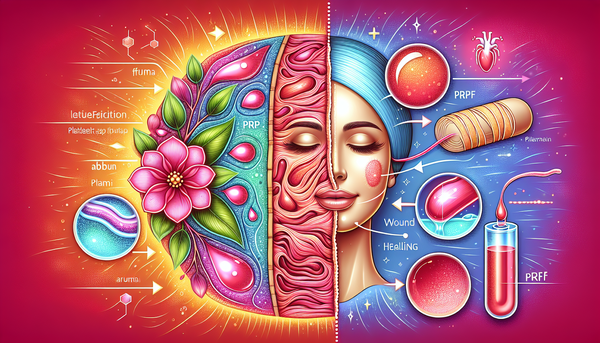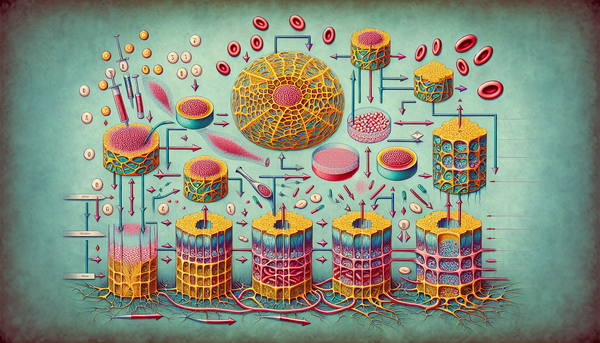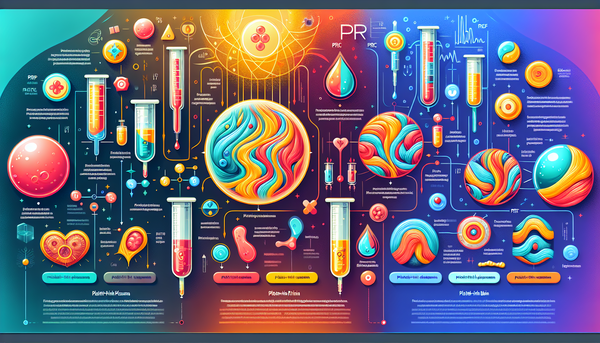

Struggling to choose between PRP and PRF? This guide will break down the key differences, benefits, and uses of each treatment, helping you decide which—PRP or PRF—is right for you and best suits your needs.

Platelet Rich Plasma (PRP) therapy is becoming increasingly renowned for its abilities to foster healing and rejuvenation. The process involves drawing a small sample of the patient’s blood, which is then processed in a centrifuge to isolate platelets from other blood elements. This concentrated Platelet Rich Plasma, packed with growth factors and cytokines, can promote tissue repair and expedite the recovery process.
With wide-ranging applications across multiple areas of medicine, such as orthopedics and dermatology, PRP treatments have become sought after for managing conditions like osteoarthritis, injuries affecting soft tissues, and hair loss, among others. Its effectiveness lies in harnessing the body’s innate reparative mechanisms, making it an adaptable treatment choice that benefits numerous patients.
To produce PRP, a small quantity of the patient’s blood is extracted and subjected to centrifugation at high velocities. This process efficiently separates the platelets from other cellular components within the blood. Once isolated, these concentrated platelets are ready for reinjection into specified areas where they discharge growth factors that facilitate wound healing, bolster cell proliferation, and amplify collagen production.
When paired with microneedling techniques, PRP therapy can achieve even more remarkable results. The creation of minuscule perforations in the skin via microneedling enables deeper infiltration of PRP—optimizing its therapeutic capabilities—thereby leading to an improved texture of skin alongside diminished scarring effects and comprehensive rejuvenation of the dermal layer.
PRP therapy is highly beneficial owing to the abundant platelets, growth factors, and bio-proteins in plasma. These elements synergize to enhance collagen production, expedite tissue repair, and refine skin texture and tone. Consequently, PRP stands as an outstanding treatment for individuals aiming to combat aging signs like sagging skin or acne scars.
The remarkable merit of PRP treatments lies in their low risk of side effects. Utilizing the patient’s blood mitigates chances of allergies or negative reactions substantially. This natural method facilitates safe and efficient skin regeneration and healing processes, presenting a reliable option for numerous patients seeking such benefits.

Platelet Rich Fibrin (PRF) harnesses the natural healing processes of the body and serves as an advanced therapy similar to PRP. Injectable Platelet Rich Fibrin utilizes a patient’s own blood, undergoing a modified centrifugation process at reduced speeds that preserves greater quantities of white blood cells and stem cells and constructs a fibrin matrix.
This fibrin structure within PRF operates as an anchor for prolonged growth factor release, enhancing tissue repair. Due to its distinct makeup, which offers extended benefits, Platelet Rich Fibrin is especially beneficial in applications such as skin rejuvenation where durable outcomes are preferred.
Using the healing capabilities of the fibrin matrix, PRF (Platelet-Rich Fibrin) effectively leverages a dense mix of platelets, cytokines, and growth factors. When administered to specific regions through injection, it provides a continuous dissemination of these vital elements that foster extended tissue repair and rejuvenation. This slow-release process is instrumental in refining skin texture while encouraging collagen production and bolstering overall skin wellness.
PRF’s regenerative effects extend to hair restoration benefits. The procedure naturally supports hair growth by energizing hair follicles and improving scalp condition—an essential treatment for those dealing with thinning or loss of hair.
PRF therapy surpasses conventional treatments thanks to its enriched levels of growth factors and a prolonged release process, which extend the duration of its benefits. These features make it exceptionally potent for tackling pronounced wrinkles and volume deficiencies in skin rejuvenation applications. The inherent makeup of PRF also leads to minimal side effects, providing a more organic method for repair and renewal.
In the realm of hair restoration, PRF stands out as an unobtrusive strategy that encourages authentic hair growth while enhancing scalp vitality—an appealing alternative for those aiming to counteract hair loss without undergoing aggressive interventions.

PRP and PRF both utilize the body’s natural healing processes, but they exhibit notable differences in preparation methods, component concentrations, and overall efficacy. Recognizing these distinctions is essential for choosing the most suitable treatment option tailored to individual requirements.
Considered an improved version of platelet concentrate, PRF boasts superior biological characteristics over PRP due to its higher levels of platelets, growth factors, and white blood cells. This makes it a stronger candidate for specific uses. Nevertheless, for various conditions—especially within orthopedic and dermatological realms—PRP continues to be a relevant therapeutic choice.
Centrifugation plays a key role in differentiating PRP from PRF treatments. To produce PRP, the blood drawn from the patient is subjected to high-velocity spinning that segregates platelets from other elements of the blood. The concentration of platelets yielded by this method can differ based on the technique applied.
Conversely, when creating PRF, lower centrifugal speeds are employed, which allows for retaining an increased number of white blood cells and stem cells. Due to this more delicate centrifugation process, a fibrin matrix forms that facilitates a prolonged release of growth factors, thereby augmenting treatment efficacy.
The distinction between PRP and PRF is notably marked by the use of anticoagulants in the former. The inclusion of these substances within PRP ensures that clotting does not occur during its collection or administration, potentially augmenting the early stages of healing, though it might reduce how long the treatment’s effects last.
Conversely, with its exclusion of anticoagulants, PRF retains a composition closer to nature. This characteristic contributes to an extended duration of therapeutic benefits from treatments using PRF, thereby possibly enhancing ongoing patient recovery results.
Both PRP and PRF therapies are centered around the release of growth factors, which is essential for their effectiveness. PRF has been found to deliver a higher concentration of these growth factors—about 8-10 times greater than what’s present in PRP. This abundance significantly boosts its capacity for healing and regeneration.
PRF treatments stand out due to the prolonged dispensation of growth factors from its fibrin matrix. This method ensures an extended period of tissue repair, collagen synthesis, and skin renewal. Consequently, this makes PRF a more powerful alternative for various applications where enhanced regenerative capabilities are desirable.

PRP and PRF serve distinct purposes across various medical disciplines, providing specific advantages according to their applications. For instance, PRP is renowned in dermatology for its role in skin rejuvenation and aiding hair restoration efforts. It is also applied in orthopedic settings to address issues with muscles and bones. Conversely, the regenerative attributes of PRF have made it a go-to option within oral surgery, dentistry, plastic surgery, as well as reconstructive surgical procedures.
The success rate of these modalities can fluctuate depending on individual patient profiles and intended outcomes. When it comes to fostering hair growth or enhancing skin health conditionally through treatments such as under-eye care that demands delicate handling—while PRP has proven highly beneficial—it’s important to note that the benefits achieved from using PRF often persist longer.
The use of PRP has seen a rise in favor due to its ability to successfully target issues related to hair loss. By administering PRP directly into the scalp, it encourages stimulation of the hair follicles, which enhances both the promotion of hair growth and boosts overall hair density.
Those who have received these treatments often observe substantial gains in their hair’s volume along with a noticeable decrease in shedding, proving that PRP stands as an efficacious choice for individuals aiming to address concerns around thinning hair while fostering stronger and more vigorous growth of their locks.
PRF stands out in the field of skin rejuvenation due to its rich content of growth factors, white blood cells, and stem cells, which naturally aid in healing and bolster collagen production. Its use is particularly beneficial for diminishing fine lines and wrinkles and correcting uneven skin tone.
When paired with microneedling procedures, PRF’s efficacy is significantly boosted. Microneedling generates minute openings in the skin that facilitate deeper absorption of PRF’s restorative elements. The result is a marked enhancement in skin texture, along with increased firmness and a glowing complexion.
In assessing the benefits of PRP and PRF, one must take into account their unique treatment objectives and personal requirements. The composition of PRF facilitates a slower, sustained release of growth factors, which contributes to extended-lasting effects and enhanced therapeutic benefits. This positions PRF as an optimal choice for individuals aiming for lasting enhancement in skin health and aesthetics.
Conversely, PRP stands out when immediate action is necessary, particularly for acute issues. Due to its rich concentration of platelets and growth factors, it offers swift advantages post-treatment, serving as an excellent alternative for those who prioritize quick healing outcomes.

When deciding between PRP and PRF, it’s important to take into account your own goals, any existing health issues you may have, and the results you’re hoping to achieve. Each approach comes with its own set of advantages. Thus, selecting the most fitting one hinges on a person’s specific requirements and objectives for treatment.
It is essential to engage with a healthcare professional in order to identify which option—PRP or PRF—is better suited for your unique situation. Crafting a tailored treatment strategy under their guidance can enhance the benefits received from either procedure and promote superior outcomes.
Seeking professional guidance from a healthcare provider is essential when choosing the appropriate treatment. They can evaluate personal health circumstances and suggest whether PRP or PRF would be more effective, tailoring their advice to maximize treatment benefits and meet unique health requirements.
A no-cost consultation with a healthcare provider affords critical understanding of what to expect from each procedure. It empowers you to make an educated choice regarding your care plan. Take advantage of expert recommendations to achieve optimal results in your treatment journey.
When deciding between PRP and PRF treatments, it is essential to take into account several aspects such as the duration of recovery, the persistence of outcomes, and their specific uses. Visible effects from PRF treatments emerge within a few weeks and have the potential to endure for many months, thus they are often chosen for sustained enhancements.
On the other hand, advantages derived from PRP therapy could become apparent more quickly after treatment. These benefits tend to be shorter-term in nature. Recognizing these pivotal distinctions along with consulting your healthcare professional will assist you in determining which option aligns optimally with your personal requirements.
It is essential to adhere to proper post-treatment care following PRP and PRF therapies in order to achieve the best possible results while reducing potential complications. Resting and minimizing movement in the area that received treatment are critical steps patients must take to facilitate the healing process. The role of appropriate aftercare cannot be overstated, as it plays a significant role in both enhancing efficacy and prolonging the positive effects of these treatments.
For optimal outcomes, one must strictly follow their healthcare provider’s post-treatment instructions. Taking precautionary measures such as resisting the urge to touch or apply pressure on treated areas, steering clear from particular products that may interfere with recovery, and adhering closely to prescribed aftercare routines can profoundly impact your recuperation journey and eventual therapeutic benefits.
Directly following your procedure, it is essential to refrain from consuming any medications unless they have been specifically prescribed by your doctor, as they may disrupt the body’s inherent healing process. For at least six hours after treatment, patients should avoid putting lotions, creams, or makeup on the area that received treatment to avert irritation and possible complications.
We advise against applying ice or heat to the area where you received injections for up to 72 hours afterward, though using ice immediately post-treatment for periods of 20-30 minutes might be acceptable in some cases. Abstaining from it is advisable for proper healing. Adhering strictly to these instructions can assist in minimizing potential adverse reactions and facilitate the natural mechanisms involved in wound repair and recovery.
Maintaining the gains from PRP and PRF treatments requires consistent follow-up appointments. These check-ins are critical for preserving the enhancements made and overseeing ongoing treatment success. Integrating products that hydrate and nourish into one’s daily skincare routine can prolong the positive impact of these therapies.
To safeguard treated regions and amplify outcomes from PRP and PRF treatments, applying sunscreen every day is imperative. Adherence to your provider’s care directives combined with a steadfast skincare routine plays a significant role in achieving sustained benefits while minimizing potential adverse events.
In summary, both PRP and PRF offer unique advantages for skin rejuvenation, hair restoration, and overall tissue healing. PRP is highly effective for quick recovery and immediate benefits, while PRF provides longer-lasting results and enhanced therapeutic effects due to its higher concentration of growth factors. Understanding the key differences between these treatments can help you select the most suitable option for your needs.
Consulting with a healthcare provider is crucial for making an informed decision. Personalized treatment plans tailored to your specific goals and health conditions will ensure the best possible outcomes. Embrace the potential of these innovative therapies to enhance your natural beauty and well-being.
JL, Happy Patient
Want to learn more about the difference between PRP and PRF, including which option is right for you? Schedule your consultation with board certified dermatologist Dr. Nissan Pilest at Total Dermatology in Irvine, CA today. (949) 727-3800
When it comes to your skin and your health, it really is all about what’s best for you. Total Dermatology understands this, which is why we offer versatile treatments with experienced and highly trained aesthetic professionals led by Dr. Nissan Pilest. Your Total Dermatology transformation awaits.